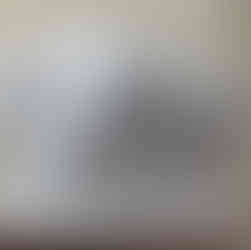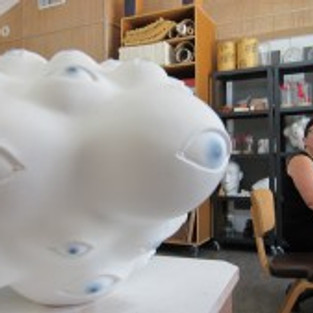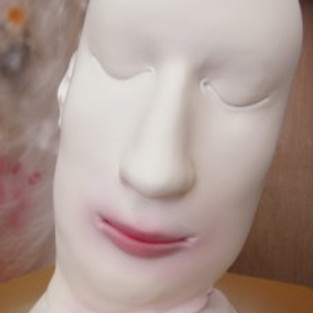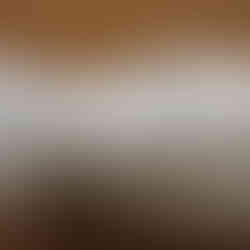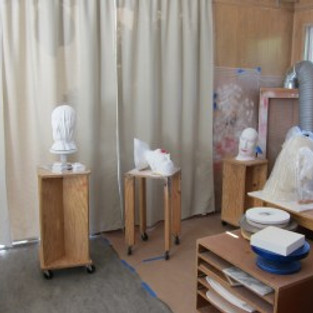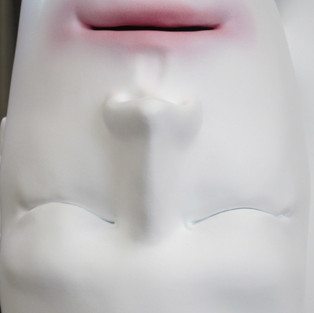
Tanya Batura. Studio visit by Gary Brewer. Photo Credit Gary Brewer
Studio Visit: Tanya Batura – Theater of Disquiet
By Gary Brewer
“Beauty is a terrible and awful thing! It is terrible because it has not been fathomed, for God sets us nothing but riddles. Here the boundaries meet and all contradictions exist side by side.” Fyodor Dostoyevsky, The Brothers Karamazov
“Pleasure only starts once the worm has got into the fruit, to become delightful happiness must be tainted with poison.” Georges Bataille
The ceramic sculptures of Tanya Batura exist in a delicate balance between stillness and distress; the mute heads become actors in a theater of disquiet. The elegant formal refinement and the exquisite sculptural sensitivity to the interplay of forms create a contemplative aura. This aura that is broken by the deformations, the bulges created by the artist’s hand, and by weight and gravity that the artist allows or encourages, these subtle aberrations, suggest birth anomalies, disease, and injury. Or from the ‘scratching’ and ‘gouging‘ away of clay from a completed head, they convey a sense of violence like the distressed walls in the cities of Europe where a history of violence has left the marks of bomb shrapnel in the facades. At times the white purity of her sculptural forms are disturbed by a scarlet red, an airbrushed highlight coloring the lips or the tongue, suggesting both a sense of the erotic – the red a signifier of passion – or of injury.
Tanya’s use of surrealist vernacular married to elegant formal design and realized in highly refined craft, add a delicious perversity to the work. Work that does not attempt to define a complete narrative but to open up subjective pathways that engage the audience eliciting an emotion that is located in the body, a vessel soft and vulnerable, naked to the violence of chance and predetermination.

Tanya Batura. Studio visit by Gary Brewer. Photo Credit Gary Brewer
I asked Tanya about the work, if she was seeking to convey fear, nightmares, or some existential dread. She replied, “ I see my work as contemplative, I am interested in beauty but there is always a backdrop of ‘disquiet’, that we are vulnerable to forces that we do not control. I want the work to affect people, to open up an emotional response that they fill in, to let it become their narratives.”
We spoke about how making something by hand has an authenticity to it that is unique and that there is a subjective and emotional force discovered through the hand ‘feeling’ a form into being. Tanya works in a process of building her forms with a fusion of coil/slab construction, building the form up one step at a time, her hands and fingers shaping the sculptures into sensuous and psychologically compelling forms. She may encourage gravity to play a role in morphing the forms, letting the wet clay naturally sag to affect a shape, a marriage of natural forces and craft, a technical feat of risk taking and exceptional control. Tanya is a master of her art. It is a process of discovery that is initiated with a vision or an image, but finds itself through a dialogue between material, hand and mind.
I was interested in her process, if the works are fully conceived a priori – if she drew out and designed them before she began, “I start with an idea, an image in mind, and then I begin to build the sculpture. The works can take a very long time to complete, sometimes a year to fully realize. With some pieces I will build it up to a certain point and then flip it over and build it from the other side. How a work ‘sits’ can become a critical issue. I may start with an idea of where the bottom is, but find that another position creates a more complex feeling, or some other subjective quality that affects the impact of the work by it orientation. Composition is important too, and another reason some pieces are completed and then turned. And finally, if I choose to add color, what color and where, I can sit with a piece for a long time before I sense what to do.”

Tanya Batura. Studio visit by Gary Brewer. Photo Credit Gary Brewer
As we spoke I was looking at a particular piece, a form suggestive of a cloud made up of myriad breast-like bulges. Each bulge was adorned with an eye, each eye was a different size. The sculpture is both playful and disturbing, various faces of human, animal or alien are conveyed, shape shifting in ones mind as you focus on different parts of the work. She said of this piece. “This sculpture took almost a year to complete. I finished the overall form and then had to carve out the eyes, a very delicate process. Afterwards I thought about whether I wanted color or to leave it white. It sat for a long time while I considered that. I then decided on blue eyes, there is something so mysterious about a person with blue eyes, they are piercing and arresting.”
I asked Tanya if there was an event or an experience that first spoke to her and illuminated her interest in the subjective thread that connects her work to the body, to the distortions and emotional tenor of her work. Coincidentally I asked if she knew of the Mutter Museum in Philadelphia and if that museum of medical specimens, (jars with fetuses of Siamese twins and other deformities), interested her. She said “That is curious you should ask that. When I was 14 years old my older sister who is also an artist took me took see both the Mutter Museum and the banned exhibit “The Perfect Moment” by Robert Mapplethorpe. The impact of these two experiences had a profound effect on my sense of self. It was also strange that the Mutter Museum was impeccably elegant, red walls and carpets, polished wood and brass. The immaculate refinement of the presentation of these disturbing bodies and various body parts was compelling. Then the Mapplethorpe show, the emotional power and the subversive nature of the work had a big impact on me. Mapplethorpe was a master of his art. His work was technically precise, coupled with the dark subject matter. And it is the marriage of technical mastery and subject matter that make his work so beautiful and evocative. These experiences left a mark on my subconscious.”
Tanya told me about her history, of self-identifying as an artist from a very young age, of first coming to clay as her medium while in college. And of her early work that dealt with sexually explicit subject matter, such as a humorous suite of black ceramic dildos, each one in a different length, shape or thickness for each day of the week, or a hanging ‘coffin’ quilt, hand sewn in black leather, a quilt of leather squares each square adorned with a nipple. The work had the same immaculate craft and exquisite presentation as her current work does. Like Bataille’s ‘worm in the fruit’ it is a marriage of beauty coupled with something dark in our nature, in the nature of our bodies that allows ‘happiness to become delightful’; the fragrant ‘taint of poison’ must always be in the air.
An artist seeks to discover something true to them selves, it is a quest into an ambiguous realm at best. We can never know the contour of our expression, it exists in a time frame that surpasses the allotment we are given. We can only search by creating work with our body, mind and soul, leaving a psychic imprint in this material world, a thumbprint in the clay from which we are made.
Tanya Batura’s work seeks to disrupt the complacency of the pedestrian world, to insert an emotion that subtly penetrates the psychic fabric of our everyday notions and to cast a shadow of ‘disquiet’ into ones consciousness. It is a reminder that these bodies, our selves, exist in a world where ‘normal’ is a concept that is a thin veil to history and the realities that surround us. It is a poetic journey that is both beautiful in its form and presentation but oscillates between stasis and kinesis, classical restraint and emotional rupture. It is a ripple disturbing the calm, an echo in a silent room that reminds us of our mortality and that this dream too shall end, it is beauty and death balanced on a razors edge.
#losangeles #california #losangelesartist #santamonica #art #studiovisit #losangelesart #contemporaryart #southerncalifornia #abstract #collage #photography #artgallery #TanyaBatura #gallery #museum #artandcake #artopening #artexhibition #installation #ArtandCakeLA #fineart #artists #artist #garybrewer #mixedmedia #arts #environment #sculpture #ArtandCulture #exhibition #exhibit #dtla #drawing



